Introduction: In this article, Mary Harrell-Sesniak shows how you can date old, undated family photos by first figuring out what type of photograph they are, and uses old newspapers and other sources to illustrate different types of photos. Mary is a genealogist, author and editor with a strong technology background.
Do you have a box of old, undated family photos somewhere up in the attic—or maybe buried in the back of some closet? Have you wondered how you were ever going to figure out who these family members might be, since the old photographs lack inscriptions or dates?
Genealogy is a lot like detective work, gathering clues to make the pieces of your family puzzle fit together. Old, undated family photographs are pieces of evidence, clues that—if you examine closely enough—might yield some answers.
By knowing a little of the history of photography, you might be able to solve the mystery of those old photos by first recognizing what type of photograph they are—which in turn will help you narrow down the date range for when the photo was created. This blog article will help you do that.
The First Affordable Camera
We’ll start with a brief primer on the history of photography. Many think that the photography revolution began with George Eastman and Frank Brownell (of Kodak) in February of 1900, when they introduced the “Brownie,” the first affordable camera. (See http://www.brownie-camera.com/ for everything you ever wanted to know about this early camera for the mass market.)
Here is an advertisement for the Brownie camera from a 1921 Washington, D.C., newspaper.
![evening-star-newspaper-0814-1921-kodak-brownie-camera-ad What the 2A Brownies [Cameras] Do, Evening Star newspaper advertisement 14 August 1921](https://blog.genealogybank.com/wp-content/uploads/2013/10/evening-star-newspaper-0814-1921-kodak-brownie-camera-ad.png)
However, in my opinion, the true photography revolution started at least 50 years prior, with the French inventor Joseph Nicéphore Niépce (1765-1833). His 1826 heliograph “View from the Window at Le Gras” became the first permanent photograph. (See http://en.wikipedia.org/wiki/Nicéphore_Niépce.) It was created with a camera obscura, a device used by artists to project images on a wall or screen. Niépce captured his view by projecting onto a pewter plate coated with a type of asphalt called bitumen of Judea. After a long eight-hour exposure time, the image became affixed.
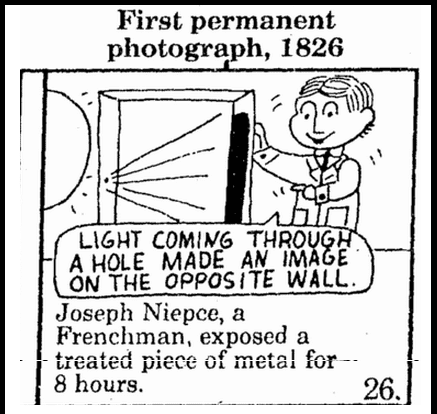
It’s doubtful that you’ll find a heliograph in your personal ancestor photo collection, but with any luck, you’ll find a variety of other types of photos. Perhaps your family pictures are identified—but in all likelihood many are not, so narrowing time periods for the creation of each photo is important in trying to date them.
Some of my earlier GenealogyBank Blog posts provided other tips for dating undated photographs, including one showing how historical newspapers can assist greatly with photo dating by comparing the clothing of people in your undated photos to clothing styles shown in old newspaper advertisements. (See a list with links to these photography-related blog posts at the end of this article.)
You can also use historical newspapers to learn how to recognize photographic types, and also to research photography studios, as shown by the newspaper articles used in this blog post.
Photographic Timelines
To start, familiarize yourself with photographic timelines, such as the timelines available in the list of websites below. Although there are numerous types of photographic processes, most of your old photos are probably ambrotypes, daguerreotypes, tintypes, cabinet cards or carte de visites (CDVs), along with some lesser-known types such as cyanotypes.
- History of Photography by the Public Broadcasting Service (PBS) at www.pbs.org/wgbh/amex/eastman/timeline/
- History of Photography Timeline at http://photo.net/history/timeline
- PhotoTree.com at http://www.phototree.com/identify.htm
- Timeline of Photography Technology from Wikipedia at
- http://en.wikipedia.org/wiki/Timeline_of_photography_technology
Representative Samples of Different Photographic Types
To see examples of different types of photos, use your favorite search engine such as Google. After searching for a specific type, such as a daguerreotype, click the image option.
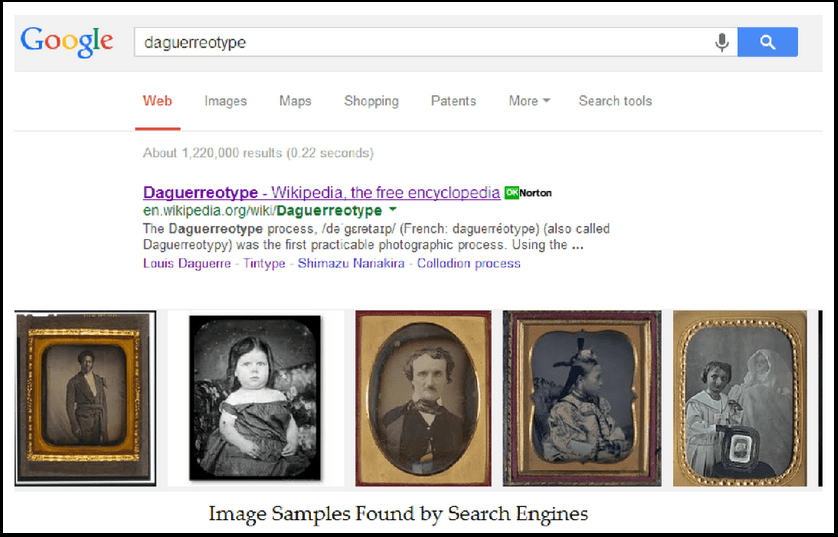
Ambrotypes
A distinctive characteristic of an ambrotype is that the image is a positive image created on a transparent sheet of glass, by what is known as wet plate collodion printing. James Ambrose Cutting is credited with the process, which dates to the early 1850s.
The Wikipedia article at http://en.wikipedia.org/wiki/Ambrotype has several examples, and mentions that many were hand tinted. If you think you have an ambrotype take note of the casing, as the style can also be a clue to the time period.
Carte de Visites and Cabinet Cards
Although these two types of photos are different, I’ve chosen to group them together because they are commonly confused. Both types were printed on paper or card stock, and originally created through a type of albumen printing which was used to bind images to paper.
Carte de Visites (CDVs or Cartes)
The Carte de Visite was made in 1850 by Louis Désiré Blanquart-Evrard (1802-1872), and is known as the first pocket-sized photograph. It is also referred to as a calling or visiting card.
He created a negative and made varying sizes, but typically his photos were small and in the range of 2 3/8” x 4” to 2 ½” x 4.” The smaller size of CDVs offered the advantage of portability and affordability. If you are lucky, you’ll find the photographer’s name imprinted on the back.
This example, rescued from an antique shop near Austin Texas, is tentatively labeled “George W. Bohun.” I believe it was shot by Rudolph Uhlman who, according to a University of Missouri-Kansas City article “A Preliminary Survey of Photographers and Artists in St. Joseph Missouri 1859 to 1889” by David Boutros, worked at 225 Edmond Street between 1876 and 1885. (See http://www.umkc.edu/whmckc/Scrapbook/Articles/StJoePhotographers.pdf.)
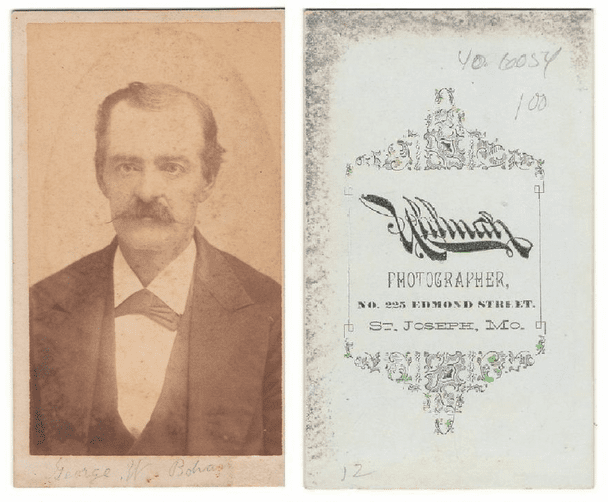
Cabinet Cards
Cabinet cards were introduced in 1864 by a British studio called Windsor & Bridge. As they were larger (typically 4” x 6” or 4 ½” x 6 ½”) and printed on card stock, they were more durable than other paper types.
The photographer’s name can be printed on the front or the rear, and the presentation (font, coloring, etc.) can also be a clue to the time frame of the photo. (See Marshall University’s article at http://www.marshall.edu/library/speccoll/virtual_museum/photographers/cabinet-cards.asp.)
This cabinet card from my photo collection identifies the photographer as James S. Cummins. Research shows he lived from 1841-1895, and if my guess is correct, this sepia-toned image was probably taken between 1875-1885.
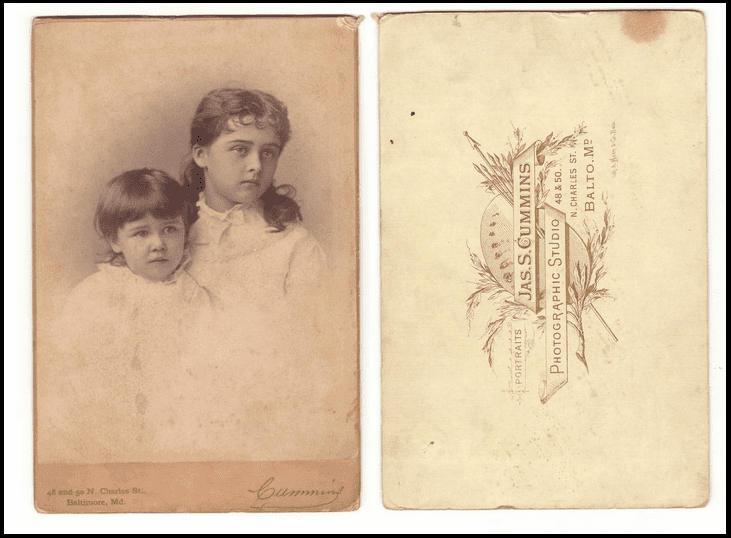
Cyanotypes
The discovery of the cyanotype process is credited to scientist/astronomer Sir John Herschel (1792-1871), but botanist Anna Atkins (1799-1871) gets the credit for applying the technique to photography. She used it to record images of plants for her research, as described in this 1982 article from a South Dakota newspaper.
![aberdeen-daily-news-newspaper-0629-1982-margaret-lockwood Lockwood at Dakota Midland [Hospital Art Gallery], Aberdeen Daily News newspaper article 29 June 1982](https://blog.genealogybank.com/wp-content/uploads/2013/10/aberdeen-daily-news-newspaper-0629-1982-margaret-lockwood.png)
This cyanotype from my collection is of an ancestor born in 1875, and I estimate it was taken between 1893-1900.
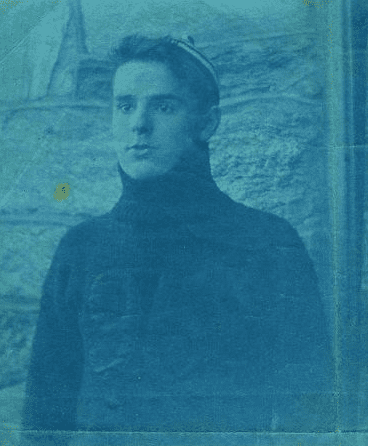
Daguerreotypes
To learn more about Niépce’s colleague Louis Daguerre (1787-1851), see these resources:
- Daguerreian Society at http://daguerre.org/
- Wikipedia http://en.wikipedia.org/wiki/Louis_Daguerre
Daguerre is credited with inventing a new photographic process known as daguerreotype.
His technique also incorporated the camera obscura, but by introducing copper plating with a thin layer of silver exposed to the fumes of iodine crystals, he was able to capture the images. Daguerreotypes were very popular from the 1840s into the 1860s or early 1870s.
After his death, Daguerre was described in this 1851 Massachusetts newspaper as “a scene painter and dioramist in Paris, an ingenious mechanic, and tolerable chemist.”
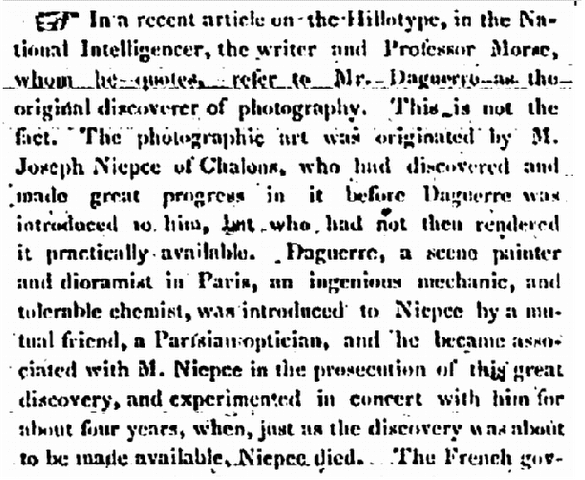
Daguerreotypes (or dags) changed the world of photography, offering our ancestors their first opportunity to sit for portraits. Many appear to be serious or grimacing in their portrait—which, some people today speculate, was from having to sit still for a long time while their picture was being taken.
However, this may be somewhat of a myth. Exposure time ranged from 60-90 seconds, and after 1845 the sitting time was reportedly just a few seconds. If one wanted multiple pictures, there was no way to make copies of the original—so multiple sittings would have to occur.
This 1841 ad from a New York newspaper promoted a daguerreotype exhibition to benefit local charities.
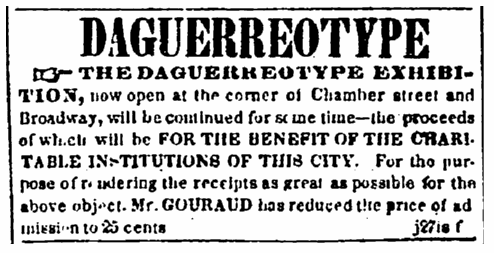
This obituary from an 1851 New Hampshire newspaper called Daguerre “the celebrated discoverer of the daguerreotype,” claiming that with this invention “he succeeded in immortalizing his name.”
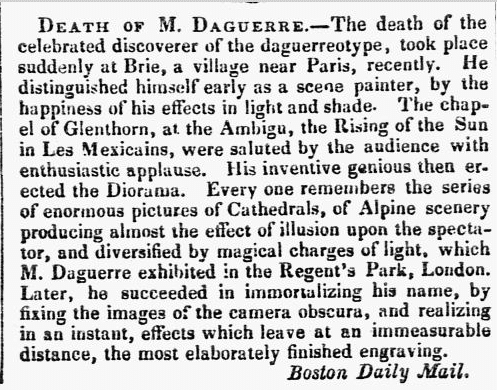
Dags of many famous people can be found online, including some of Abraham Lincoln at www.lincolnportrait.com.
Tintypes
Tintypes are another commonly-found type of photograph—although they were not created on tin.
The tintype production method is similar to that of ambrotypes. (Other common names of similar photographic processes are melanotype and ferrotype.) Tintype sizes ranged from 2 3/8” x 3 ½” to 4” x 5 ¾.”
Sometimes they were created with a wet plate and at other times with a dry plate. The image was underexposed and darkened by lacquering or other methods, and then coated. Interestingly, the metal used was not tin, but a very thin iron that resembled tin. (A magnet can determine if there is metal in your picture.)
Since tintypes were often taken at carnivals, many have a fun quality about them. Notice in this tintype (a Library of Congress image), a man was seated before two mirrors placed at right angles, in order to provide five images.
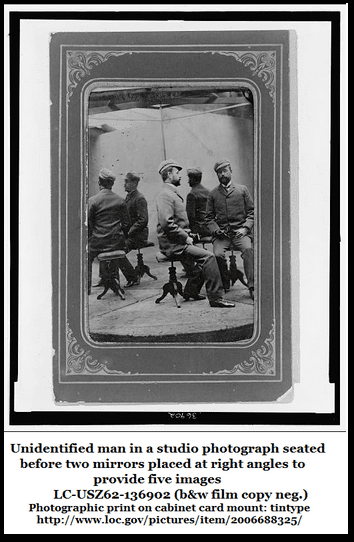
Tintypes were often sold in a paper sleeve for protection. However, if your tintype still has the original paper sleeve, don’t be fooled by the location printed on it—it may not be correct. According to this 1901 article from a Kansas newspaper, tintype sellers had a variety of preprinted sleeves from distant locations that came “in handy for people who like to put up a bluff that they have been further away from home than they really have.”
The newspaper article imagined a conversation between a tintype seller and his customer:
“What place did you say? Coney Island or—”
The maid looked at the man sheepishly. “Let’s put it New Haven,” she said. “That will sound better than Coney Island.”
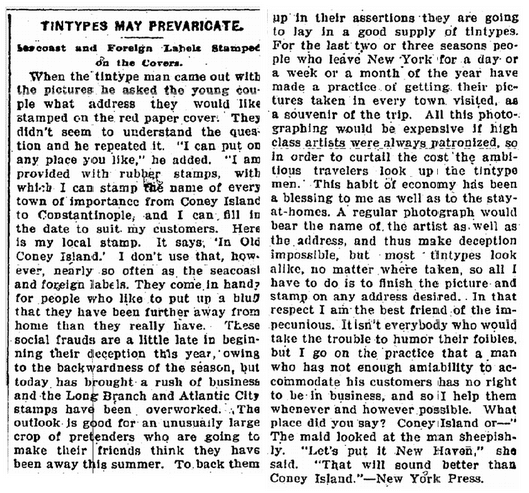
To learn more about tintypes and the other commonly-used photographic processes, revisit the timeline at Phototree.com (http://www.phototree.com/identify.htm). The site also has tips to help you identify the characteristics of pictures.
Although this is just a sampling of photographic types, hopefully this article gives you a few ideas on how to identify and date your family treasures.
Go get that box of old family photos and look at them closely. Can you identify what type they are, and thereby limit the date range for the people in the picture? Good luck with your detective work!
Related GenealogyBank Blog articles:

I am so glad I found your blog and twitter account today! I teach a high school genealogy and photography class and I’m always looking for new ideas and supplemental items. Wonderful!!!!!!!!!!!!! I’ll keep in touch!
I have a 2.5″x2.5″ snapshot, it is either my sister or myself, we looked a lot a like but there is 9 years difference, she was born in 1951 and I in 1960. Is there any way I will ever be able to tell when it was taken. It is of one of us in a diaper so no clothes, no houses, nor cars. It is in bad shape, but it is the only childhood pic of whoever it is. Can you help.
Thankyou
Dawn
Dawn,
This is an interesting challenge and one that may not be solvable.
Some people compare the distance between various facial features (eyes, nose) to see if they can find a match, but since this is a baby picture, it is doubtful it will work. Hope you solve this puzzle some day.
Mary
Nice site! I am curious about the time frame for a Domed Oval b/w photo with added color. It is 19.5″ X 13.5″. Thanks for any info
Also, it is on a cardboard like thick paper. Thanks
Jim,
What an exciting treasure.
Unfortunately I am unable to tell you much. Try getting an expert to examine it as hand coloring started very early. It would also be important in determing the proper care. Please follow up when you learn more about it. See https://en.wikipedia.org/wiki/Hand-colouring_of_photographs.
Mary
I have written a free comprehensive guide to dating very early photographs.
“Fixed in Time” is a guide to dating daguerreotypes, ambrotypes and tintypes by their mats and cases, for historians, genealogists, collectors and antique dealers. It is available as a free PDF or as a print-on-demand book.
“Fixed in Time” illustrates a thousand daguerreotype, ambrotype or tintype mat and case styles, each dated according to the years they were used. Some mats and cases were used for only a brief time, allowing you to date some early photographs to within a year. The dates provided are based on my own research, a five-year labor of love, where I located nearly 5,000 objectively dated early photographs.
You can get “Fixed in Time” at
https://fixedintimebook.blogspot.com/
This book would not have been possible without the assistance of the many institutions, collectors and antique dealers who shared their expertise and their dated images, provided illustrations, and made many suggestions and corrections. Thank you, all.
– Sean William Nolan
On page 250 of the Pdf preview there is an “Octopus Garden” design. I was wondering if that dates from the design itself or is just a playful tag added by the author.
Yes, a playful tag. I am the author. With a thousand designs to keep track of, I needed to give them distinctive names which I could remember. Some of the case names are puns. So far, no one has called me on that.
How do I date a photo on what I think is a kind of cardboard?